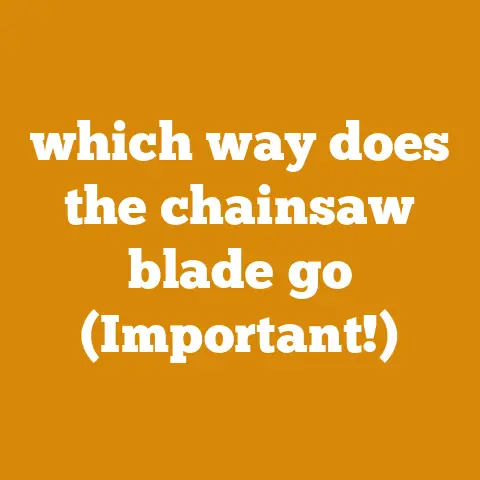What Is the Difference Between Chainsaw Chains (4 Key Factors)
Focusing on the resale value of your chainsaw can be a surprisingly rewarding endeavor.
I know firsthand how a well-maintained chainsaw with the right chain can fetch a good price when it’s time to upgrade.
Whether you’re a seasoned pro or just getting started, understanding the differences in chainsaw chains is crucial.
Let’s break down these differences through four key factors and explore how each affects your chainsaw’s performance and value.
Chainsaw Chains: 4 Key Factors
1. Chain Type
Chainsaw chains come in a variety of types, each designed for specific tasks and skill levels.
Here’s a deeper dive into the most common types:
Full Chisel Chains
When I first started using full chisel chains, I was working in a heavily forested area with a lot of hardwood trees like oak and maple.
These chains are fantastic for cutting through hardwood quickly due to their square-cornered teeth, which make aggressive cuts.
However, they can be a bit tricky because they dull more quickly when used on dirty or frozen wood.
During one particularly challenging job, I learned this the hard way and had to stop frequently to sharpen my chain, which was a valuable lesson in choosing the right chain for the job.
Semi-Chisel Chains
On another occasion, I switched to a semi-chisel chain when working in a mixed woodland area with lots of softwood trees like pine and fir.
The rounded corners of the teeth are more forgiving on dirty wood and don’t dull as quickly as full chisel chains.
This versatility makes them perfect for general use, especially if you’re cutting both hardwood and softwood.
Low-Profile Chains
Low-profile chains are designed with safety in mind, often featuring anti-kickback designs that are ideal for consumer-grade saws.
They cut slower but offer greater control, which is perfect if you’re less experienced or working in a more controlled environment like a backyard or garden.
Skip Tooth Chains
If you’re using a longer guide bar, skip tooth chains can be especially helpful.
These have fewer teeth, which reduces drag on longer bars and can make cutting larger trees more manageable.
I remember using these for the first time on a particularly large tree and being surprised at how much easier it was to handle my saw.
Choosing the right type of chain not only improves efficiency but also plays a crucial role in maintaining your chainsaw’s condition.
This can significantly impact its resale value.
2. Pitch
The pitch of a chain refers to the distance between any three consecutive rivets divided by two.
It’s a critical factor in determining the compatibility of the chain with your chainsaw’s guide bar and drive sprocket.
Let’s explore some common pitches:
1/4″ Pitch
This light-duty pitch is typically found on small, handheld chainsaws used for pruning and trimming.
These are great for lighter tasks around the garden or yard.
3/8″ Low Profile Pitch
Popular among small to medium-sized chainsaws, this pitch offers a good balance between cutting speed and control.
It’s ideal for general-purpose use and works well for most homeowners.
.325″ Pitch
Often found on medium-sized saws used in professional applications, this pitch provides a faster cut than 3/8″ low profile but maintains control and versatility.
I used this pitch extensively when working on site clearing projects where speed was essential but precision was also required.
3/8″ Pitch
This heavy-duty pitch is standard on professional-grade saws and is often used for felling larger trees.
It offers maximum cutting speed but requires more skill to handle safely.
Matching the pitch with your bar and drive sprocket is essential for optimal performance.
I’ve seen folks overlook this detail, leading to poor performance and increased wear on their equipment, which can severely affect resale value.
3. Gauge
The gauge of a chain refers to the thickness of its drive links and needs to fit snugly into the bar groove.
Mismatched gauges can lead to binding issues or even derailment of the chain during operation.
Let’s look at some common gauges:
.043″ Gauge
This light-duty gauge is commonly found on smaller chainsaws intended for lighter work like pruning or trimming branches.
.050″ Gauge
The most common gauge for general use, .050″ offers a good balance between strength and flexibility.
It’s versatile enough for most tasks, from light pruning to moderate tree felling.
.058″ & .063″ Gauges
These heavier gauges are found on professional-grade saws used for demanding tasks such as logging or milling large timber.
They provide extra strength and stability needed for high-stress applications.
Ensuring that your chain’s gauge matches your bar is crucial to prevent damage to both the chain and the bar itself.
4. Cutter Material
The material of the cutter plays a pivotal role in determining how long your chain will last between sharpenings and how well it performs under different conditions.
Standard Steel Cutters
These are common on most consumer-grade chainsaws and are suitable for general use.
However, they require frequent sharpening, especially when cutting harder materials or dirty wood.
Carbide-Tipped Cutters
If you’re working in harsh conditions—like frequently cutting through dirty wood, frozen timber, or even encountering nails—carbide-tipped cutters are worth considering.
They’re more expensive initially but last significantly longer between sharpenings, saving you time and effort in the long run.
Investing in the right cutter material can mean less downtime and maintenance costs, which is a big plus if you plan to sell your saw later on.
Personalized Storytelling & Experiences
I remember one particular project where we were clearing land after a storm had brought down several large pines and oaks.
My team and I were using different chainsaw setups based on our personal preferences and the specific tasks at hand.
One of my colleagues swore by his full chisel chain for slicing through those big oaks quickly but had to constantly sharpen it due to dirt in the bark.
In contrast, I opted for a semi-chisel chain because we had to deal with some softer woods too, and I didn’t want to bother with sharpening mid-job.
It turned out to be a wise choice because we were able to keep working without interruption while still maintaining decent cutting speed across different types of wood.
Equipment Requirements & Prerequisite Knowledge
Before changing or selecting a chain, it’s important to have some basic knowledge about your chainsaw’s specifications:
- Bar Length: Knowing your bar length is essential as it impacts the chain’s pitch and gauge requirements.
- User Manual: Familiarize yourself with your chainsaw’s user manual to locate important specifications and maintenance guidelines.
- Tools Needed: Gather tools like a chain breaker, file kit, depth gauge tool, bar wrench, and proper protective gear (gloves, goggles).
Safety Precautions
Safety should always be your top priority when working with chainsaws:
- Ensure that your chainsaw is powered off before making any adjustments.
- Wear appropriate protective gear including gloves, goggles, ear protection, and steel-toed boots.
- Check that the chain tension is correct before use; too loose can lead to derailment while too tight can cause excessive wear.
- Be mindful of kickback potential when working with full chisel or skip tooth chains, especially if you’re not experienced with them.
Troubleshooting Tips & Best Practices
Here are some common issues you might encounter with your chainsaw chain and how to address them:
- Saw Isn’t Cutting Straight: Check if the chain is sharp and tensioned correctly.
A dull or improperly tensioned chain can cause crooked cuts. - Unusual Vibrations: Ensure that the chain is seated properly on the bar and that there aren’t any damaged links causing imbalance.
- Chain Keeps Coming Off: This could be due to incorrect tensioning or incompatible pitch/gauge combinations between the bar and chain.
Conclusion & Next Steps
Understanding these key differences in chainsaw chains will not only enhance your tool’s performance but also help maintain its resale value over time.
Make informed choices based on your specific cutting needs while always prioritizing safety during operation.
FAQ Section
Q: How often should I sharpen my chain?
A: After every tank of gas is a good rule of thumb or whenever you notice performance dropping significantly.
Q: Can I mix and match different brands of chains?
A: It’s best to stick with the same brand for compatibility reasons; however, if specs match perfectly across brands (pitch/gauge), mixing may work.
Q: What’s the best way to clean my chain?
A: Use a brush along with mild degreaser/detergent solutions — avoid harsh chemicals that might damage metal components over time.
Q: How do I know when it’s time to replace my chain?
A: If sharpening no longer restores effective cutting performance or if there are visible cracks/damage on cutters/links themselves — consider replacing entirely rather than risking further damage/injury from continued use!






